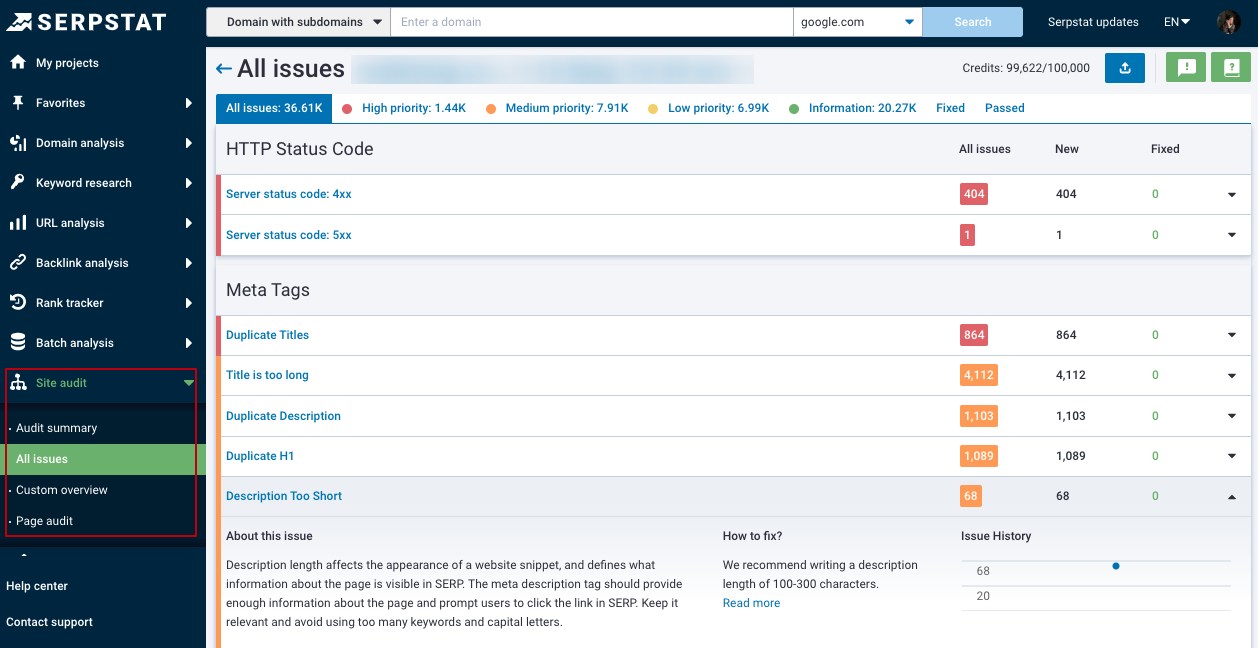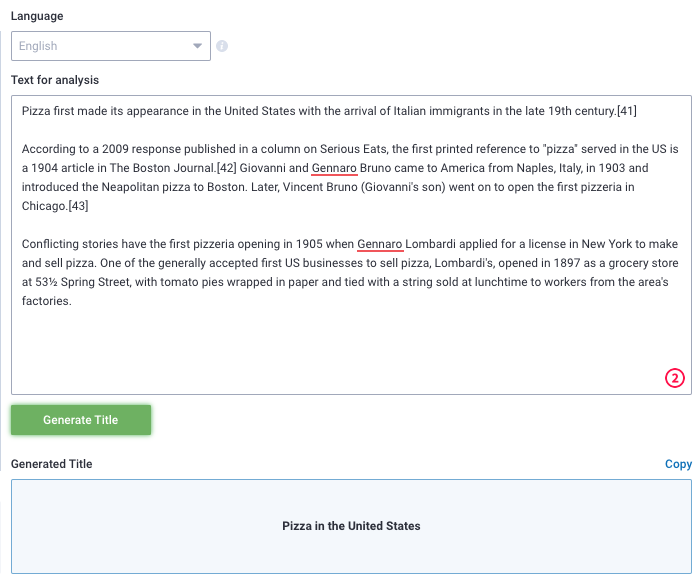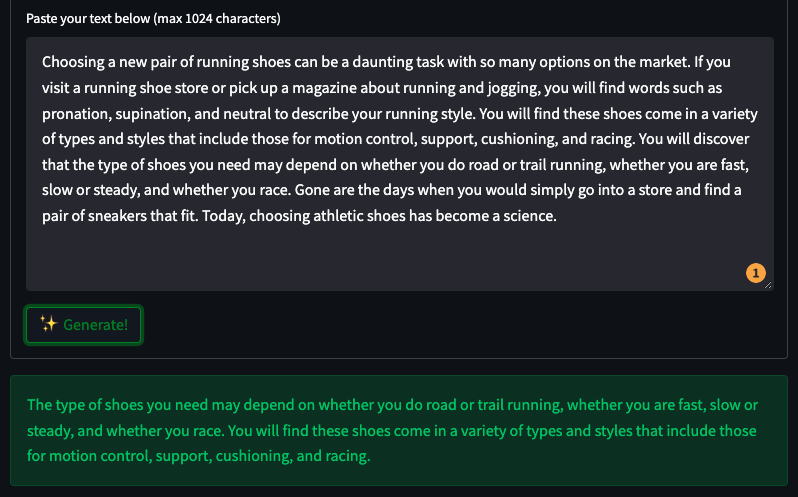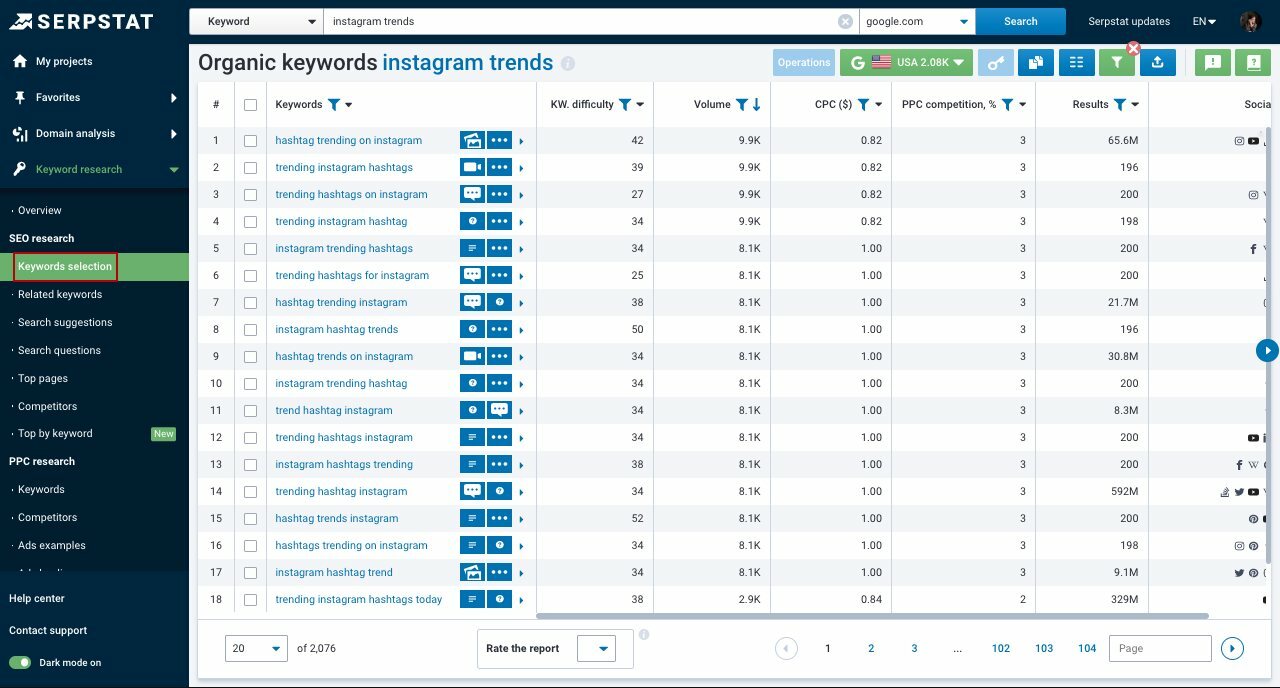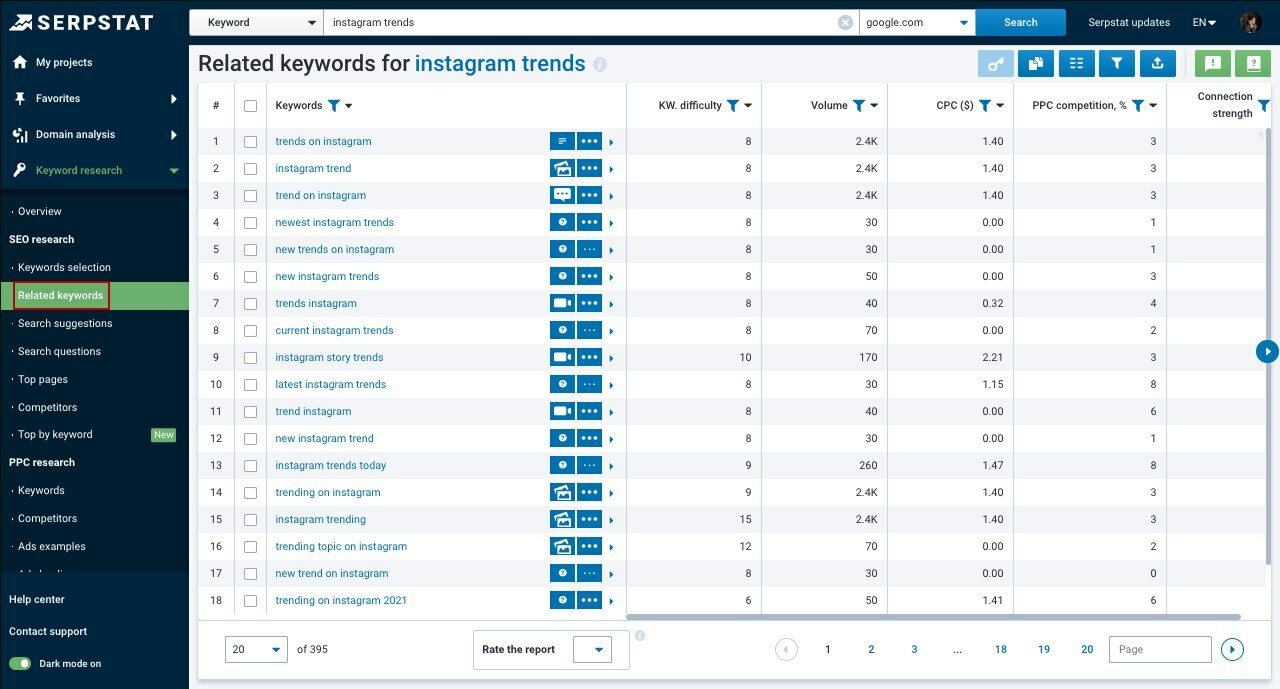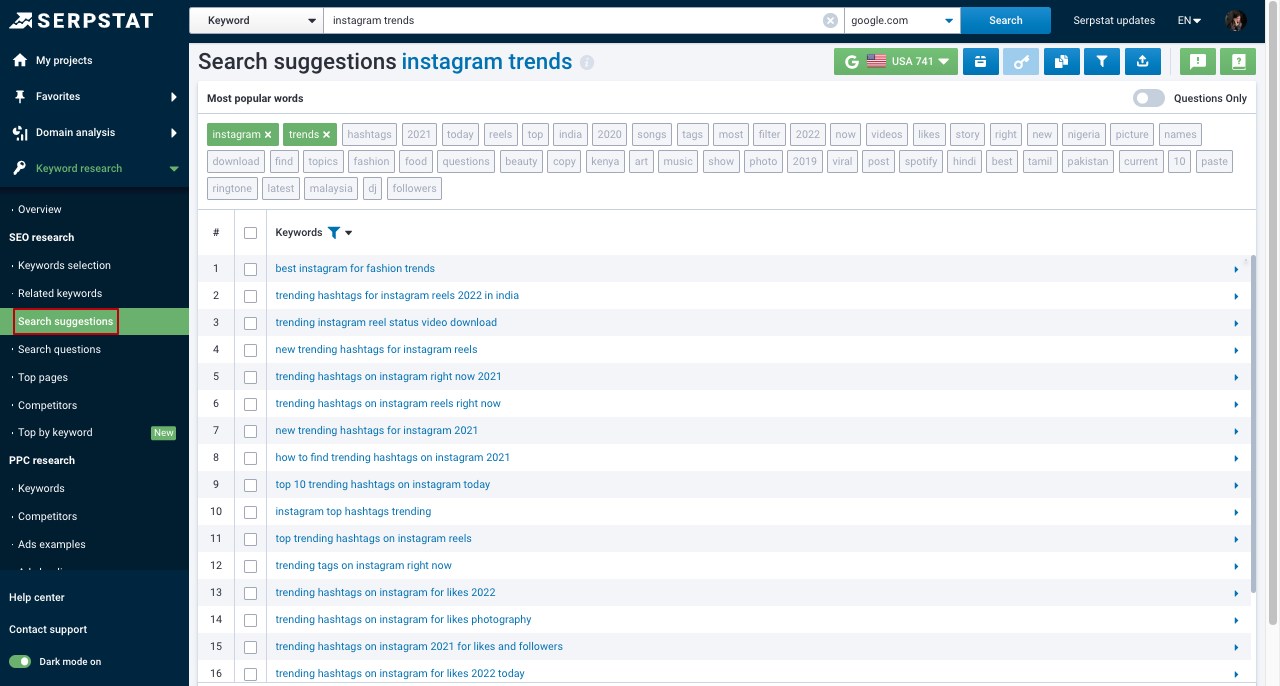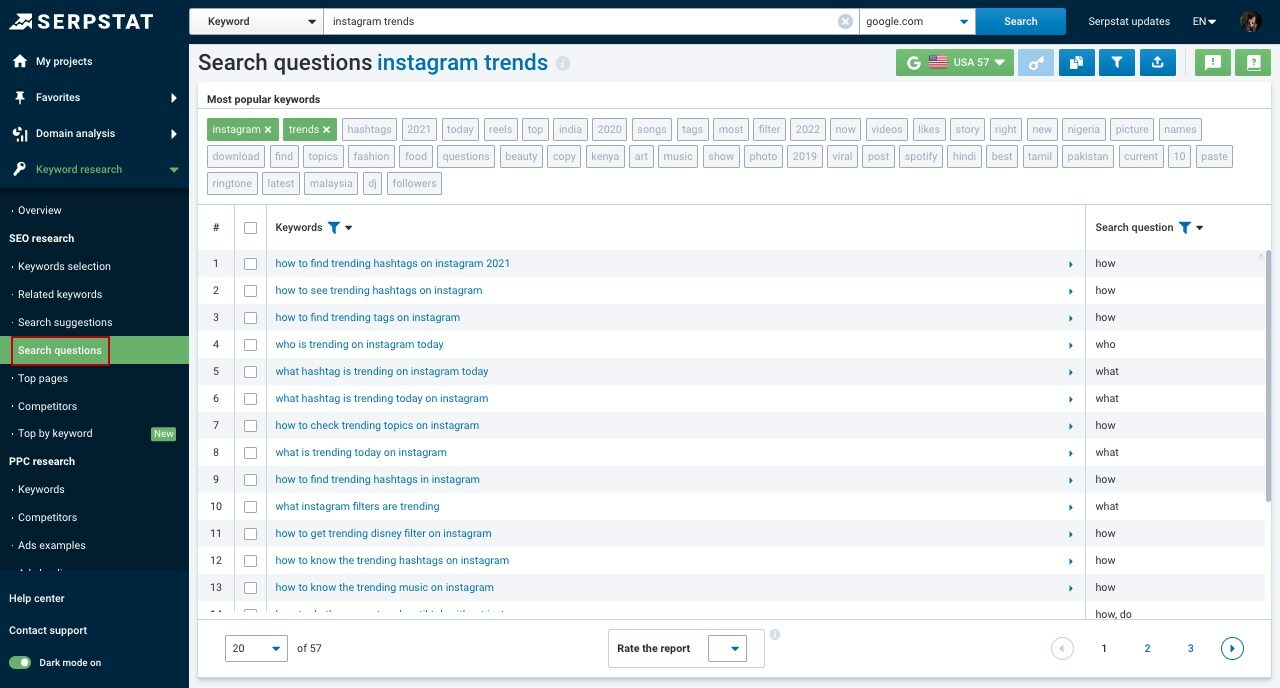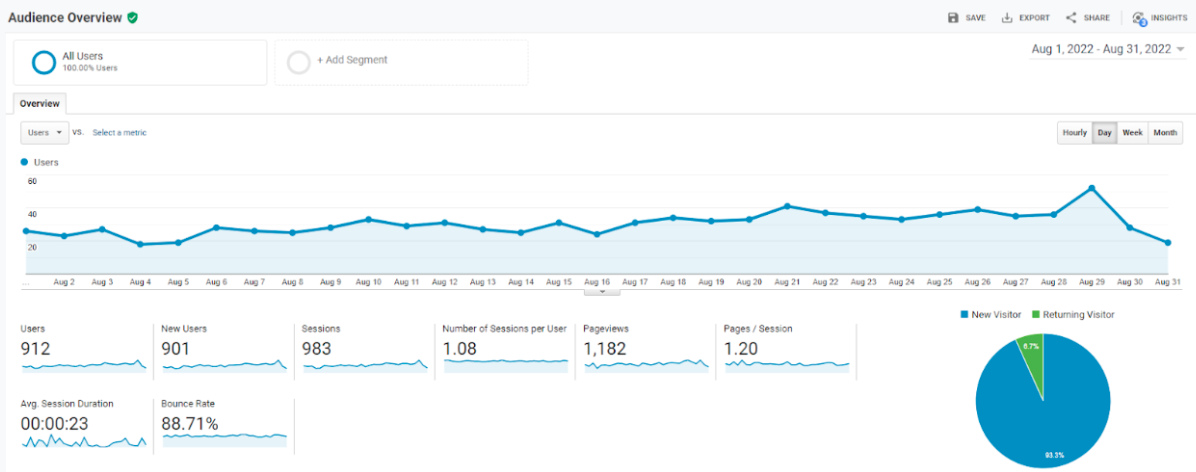Start Exploring Keyword Ideas
Use Serpstat to find the best keywords for your website
12 Website Changes to Lower Your Bounce Rate

To get more quality leads, you need to reduce your bounce rate as low as possible. And an average visitor spends more time on your site, so you get time to convert that visitor into a customer.
So if you are struggling to get more leads because of the high bounce rate of your website, this article can help you. Today we will discuss 12 website changes that can significantly lower your bounce rate.
What Bounce Rate Is Optimal For Your Website?
Reasons For High Bounce Rate
Website Changes to Lower Bounce Rate
1. Make Your Site Mobile Friendly
2. Improve Website Aesthetics
3. Make Navigation Easy
4. Improve Load Time
5. Avoid/Reduce Popups
6. Write Quality Content
7. Enhance Content’s Readability
8. Use Visual Content
9. Improve Linking Strategy
10. Include Targeted Keywords
11. Write Engaging Meta Descriptions
12. Keep Monitoring & Optimizing
Key Takeaways
What Is Bounce Rate?
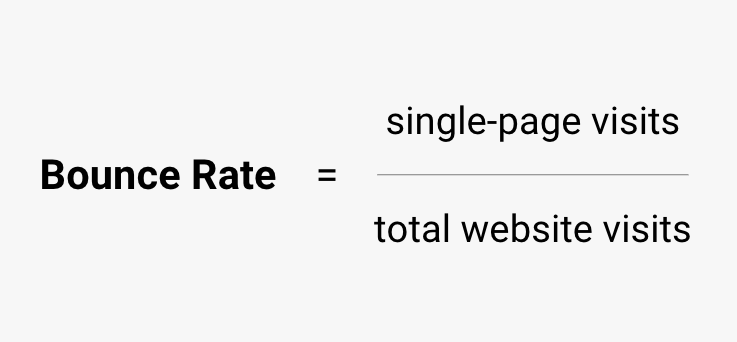
What Bounce Rate Is Optimal For Your Website?
But the question arises, what bounce rate is considerable for a website? According to Semrush, an optimal bounce rate would be in the 26% to 40% range, while a bounce rate above 80% is considered very poor.
The bounce rate varies according to industry type, device, and channel. Check out the following bounce rate benchmarks by HubSpot Blog.
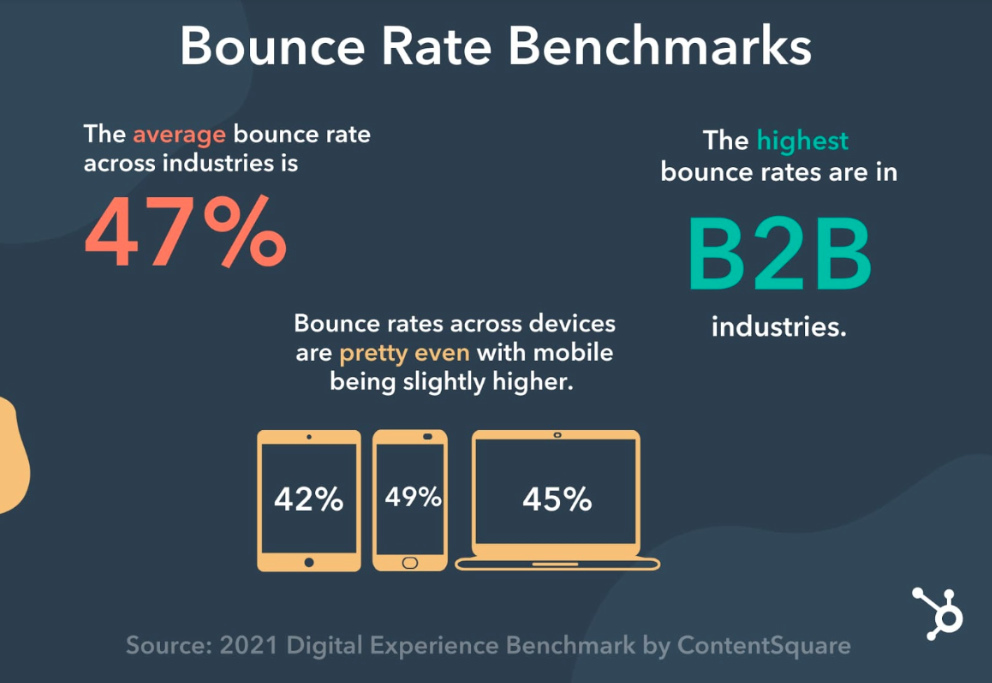
Reasons For High Bounce Rate
Here is the solution, by making these changes to your website, you can improve the user experience and lower your bounce rate.
Website Changes to Lower Bounce Rate
1. Make Your Site Mobile Friendly
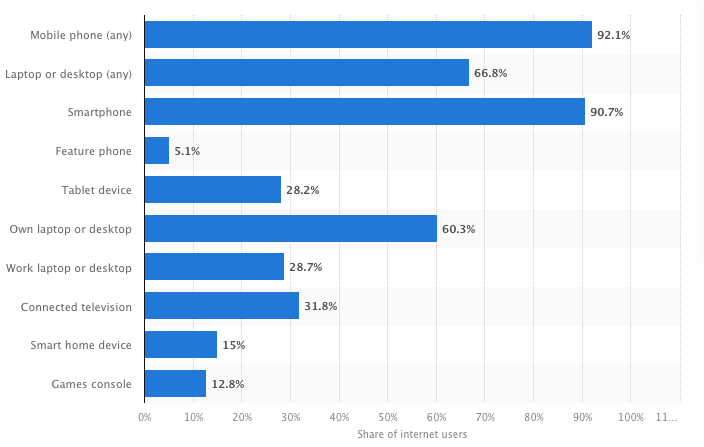
Image source: statista.com
If a potential customer visits your site using a mobile device and your site is not responsive, there are certain chances the visitor will have a poor user experience and leave your website immediately.
So the first change you need to make is to make your website responsive and mobile-friendly.
While doing so, ensure all the content, such as text, images, and videos, is visible to the viewer. The use of the available space is another essential concern. Mobile devices do not provide space as much as desktops, so you must be careful when placing different website elements in the available space. That means no element should overlap with each other or hide behind another one.
Moreover, the user experience with mobile devices is more focused than desktops because of limited space, making it super important for you to design the layout. When visitors land on your page, they get a clear idea about your site and get encouraged to take necessary action. To support this effort, you can use tools like Claspo.io, which helps you create mobile-optimized popups that seamlessly adjust to different screen sizes. This ensures your calls to action remain visible and engaging without disrupting the mobile experience.
2. Improve Website Aesthetics
Beginning with the basics, the very first thing you need to look after is the color scheme of your website. Each color has its significance and is used to show different emotions. So while selecting the color scheme of your website, you need to consider your brand values, targeted audience, and the emotional sentiments of your potential customers.
Another essential thing to consider is all the elements should be in the right place and the correct size. For instance, the text on your website should be large enough that one can read it easily. The images that you use should be of high quality. The tabs like call-to-action should be visible and correctly highlighted. And most importantly, there must be a correct flow of data that you add to your website.
And lastly, you need to focus on website design that connects with the people. Depending on the locations, you can create a Culturally Sensitive Website with different pages targeting different audiences. For example, for targeting older people, you can use a conventional design, while for a young audience, a minimalistic website design will do a better job.
3. Make Navigation Easy
Navigation is one of the most important features of a great website. Because apart from the user experience, easy website navigation makes it easy for search engines to crawl and index your different website pages more efficiently and effectively.
There are different types of website navigation. You can choose the best for your website that fits the aesthetics. But more importantly, you must focus on a navigation type that creates a smooth experience for your visitors.
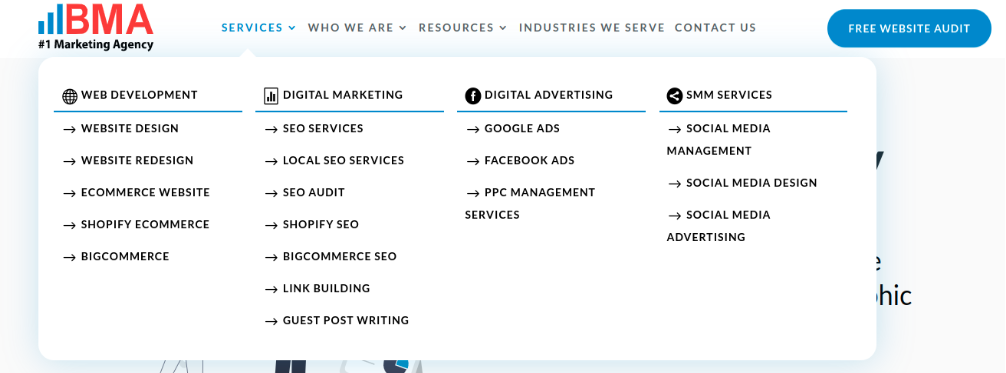
For pages with bulk content like blogs, you can add a feature like a table of contents and can include the headings and subheadings of the blog with a link that redirects to that part of the blog. It will make it easy for the reader to find the particular content.
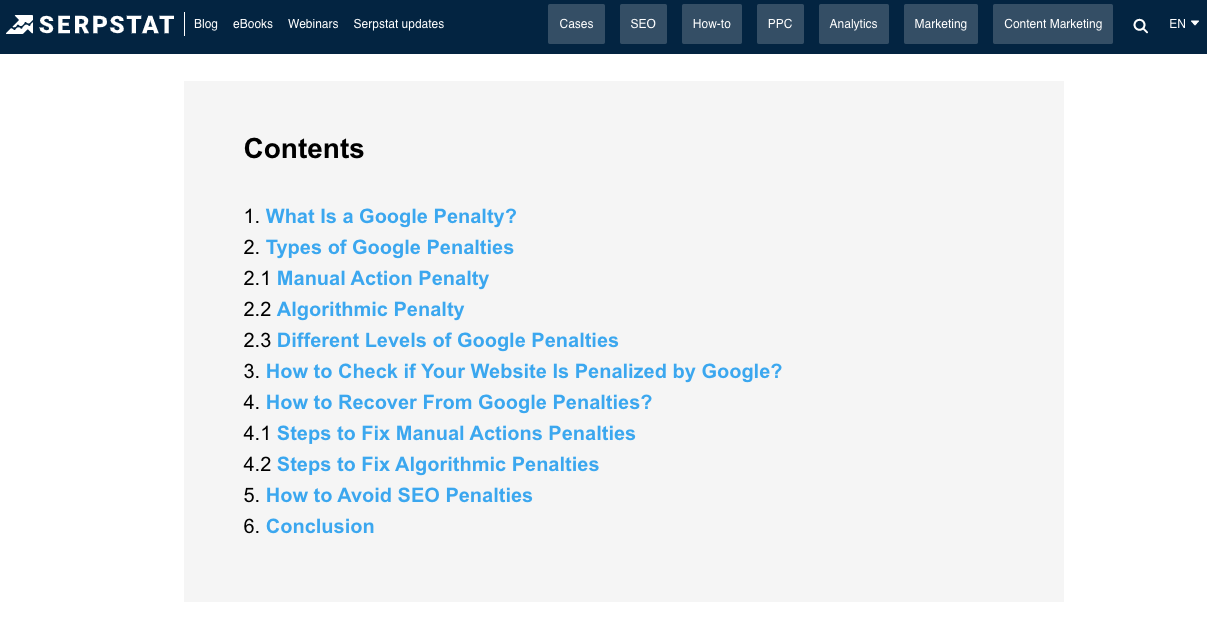
4. Improve Load Time
In general, a website must load within 1-2 seconds. If your site takes more than 3 seconds to load, it will be counted as a slow website. Besides the visitor's point of view, there are chances you may slip in rankings if your site is consistently slow.
The first thing you have to do is check your site loading time and find your website speed. Pingdom is one of the helpful tools where you can test the speed of your website. If the site speed is below 3 seconds, your website is good to go. And if not, you might need to make some changes.
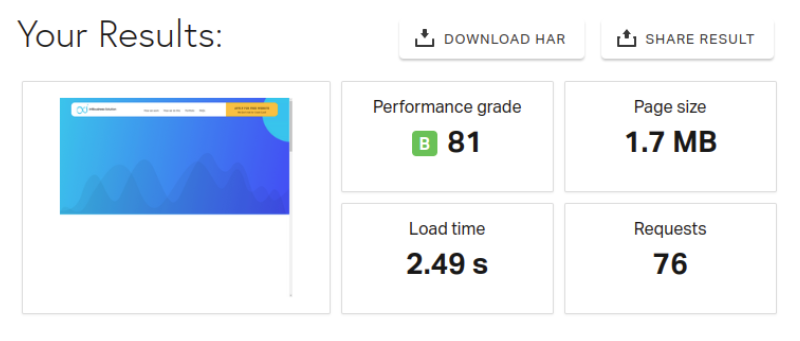
Furthermore, the images and videos on your site cause delays in loading time. You can optimize the images and compress the quality of these images and videos to improve the load time.
Eliminating unnecessary plugins from your website can be helpful too. Also, you can enable browser caching, which will store your site data in the user's browser and load the same data when the user reopens the site.
- get recommendations on speeding up site pages for computers and mobile devices;
- check all issues divided into three groups, depending on their severity: high, medium, low priority;
- find ways to solve technical problems found;
- estimate the level of site optimization by a set of criteria and our own Serpstat Domain Optimization (SDO) Score.
5. Avoid/Reduce Popups
But this doesn’t mean you should completely stop using the popups on your website. This is what can help you convert your site visitors into regular readers, but only if the popups are relevant and do not disturb the user experience.
With engaging popups, you can also generate high-quality leads that you can convert into customers. But while creating and showing such an ad on your website, there are several factors that you need to consider.
To create engaging popup ads, first, you need a clear purpose for that particular ad. Then considering that purpose and your targeted audience, you can create popup ads of different designs. The color scheme, content, text visibility, CTA line, and what value to provide to the customer are the solid factors affecting the outcomes of your ad.
Another thing you need to take into account is timing. It is crucial to decide when you are going to trigger your popup. To grab the attention, determine the right time for the popup to appear on the site. It should not be too early or too late. You can select a suitable time depending on your website content and message in the popup.
6. Write Quality Content
The new age trend of automating content creation using artificial intelligence is rapidly growing. For example, using Serpstat Content Generation and Analysis tools based on AI, you can:
- generate meta tags and articles;
- check grammar and spelling;
- paraphrase texts;
- create articles;
- highlight important insights from competitor texts, etc.
To write quality content, you first need to understand what your targeted audience is looking for. Identifying your audience will help you write user-specific content that will create engagement.
After deciding your targeted audience, write content that provides value to your reader. In the recent Google helpful content update, the search engine giant has specifically mentioned focusing on "people-first content," which means you should give more importance to information that is helpful for readers.
To create engagement with the reader, you can add a personalized touch to your content while you write. Try to explain things more relatable manner and in an easy language that everybody will understand.
And lastly, keep updating your website with fresh and updated content. Adding new blogs on the trending topics of your industry will help your website rank higher. And with value-adding content, your bounce rate will be reduced automatically.
7. Enhance Content’s Readability
To enhance your content's readability, the first thing you need to pay attention to is font and text size. The font style and size of your text significantly affect user experience. Using the right font style and size will make it easy for readers to go through the website content effortlessly.
Furthermore, strictly avoid lengthy paragraphs with lengthy sentences. Readers do not prefer reading such long paragraphs. Instead, using short paragraphs with 3-4 sentences each helps to improve the readability. Another advantage of keeping the sections short is better text alignment in all the device types.
Use different text formatting options like headings, subheadings, and bullet points. Use bold and underlined text to highlight the important content. You can use charts, graphs, tables, and similar data representation tools to represent the data. Adding the source link will validate the data you provide in your content.
Try to add relevant images and screenshots to your content. It makes it easy for your reader to understand the topic you are trying to explain. And lastly, use a tone and language that relates to your reader. Try to write in such a way you are talking to that person.
8. Use Visual Content
Content forms like videos and infographics efficiently provide the information keeping the visitors engaged and encouraging them to check other pages on your website. A well-designed visual content can lower your bounce rate and increase the website traffic you can convert into regular visitors and even customers.
Conduct industry research and discover the current trends and the issues your targeted audience faces. Based on that, you can create videos, infographic posts, and similar content that will provide solutions, tips, tricks, and hacks to solve those problems.
To improve your website loading time, instead of uploading the full video, you can add a preview of your video with a link that will redirect to your social media channels like YouTube, Instagram, and Facebook.
9. Improve Linking Strategy
Including the relevant links on your website will add value to your visitor. It improves the user experience by redirecting the site visitor to the other relevant pages. But it does not mean you should include links as much as possible. Unnecessary link stuffing disturbs the user experience and increases the chances of a higher bounce rate.
While adding a link to your website, you have to pay special attention to the anchor text of that link because an anchor text is a path between the reader and the page where that link redirects the reader. By reading the anchor text, a person decides whether to click on that link or not. The anchor text must be clear and should inform what that link is about.
Apart from that, focus on eliminating the broken links from your website as they affect the experience and reduce your site ranking. Check for all the broken links and remove them from your website. And keep checking the links regularly and ensure they are working.
While adding the external links, make sure they open in a new tab because opening in the same tab and going back to the main page can be annoying for the user.
10. Include Targeted Keywords
Including a targeted keyword ensures that your website reaches the specific audience that is actually looking for your website. Let's take an example. If you have a salon website, you must include a particular keyword, whether the salon is for men, women, or both.
If you don't include a targeted keyword, your site will appear in any random search results, and even after getting the traffic, your bounce rate will be high. Because visitors will land on your site but won't find what they are looking for.
For example, Serpstat Keyword Research tools help you find the right targeted keyword to include in your website. You can use these keywords to make attractive headlines. And also, have them in your content to help the search engine analyze them. But while doing so, add the keyword only where they are required; unnecessary keyword stuffing won't help you.
- "Related Keywords" represents all search queries that are semantically related to the searched keyword, so check and use new variations of the queries here;
- "Search Suggestions" is the report that shows the queries offered to users under the search bar;
- "Search Questions": here you can see all question forms of search suggestions. These are questions that include a selected keyword that a user is looking for an answer to.
11. Write Engaging Meta Descriptions
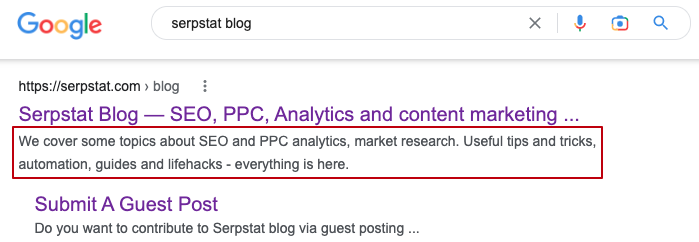
There are some easy tips for writing a compelling meta description. First, do not forget to include the targeted keyword in it. Because if there is a targeted keyword in your meta description, the chances of your web page appearing in top search results increases when someone searches that keyword.
Likewise, adding the targeted keyword once is enough, and also, make sure the keyword goes with the natural flow of content. Do not try to stuff the keywords in the meta description.
The meta description should be short, concise, and descriptive. It should tell the reader how this webpage has the solution you are looking for. Include a call to action in your meta description to create more engagement.
Have you already tried to generate a Description with the Serpstat Description generation tool we mentioned earlier? If not, here is a short instruction on how it works: you go to the "AI content tools" section → "Description generation". You paste your Serpstat API token, paste a fragment of the text from the page, and a tool composes a description according to the requirements of search engines and the analysis of competitor pages in the search results.
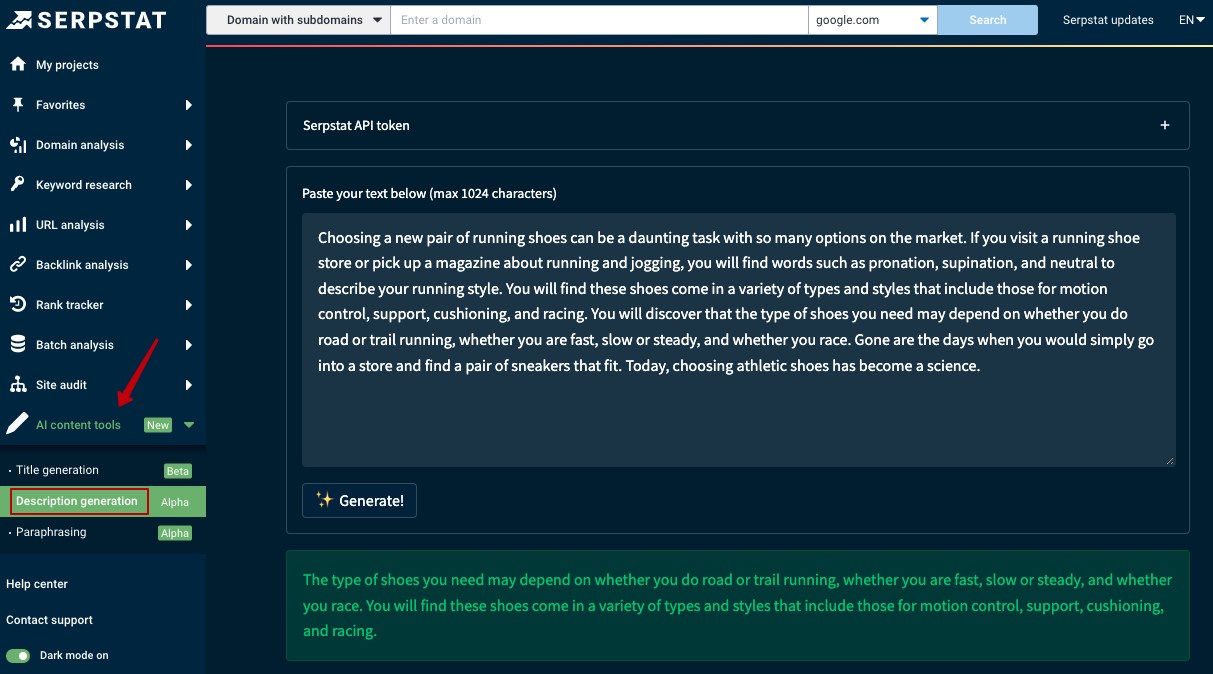
12. Keep Monitoring & Optimizing
Keep monitoring your website based on parameters like page ranking, average time spent, bounce rate, click-through rate, keyword performance, etc. And make the necessary changes wherever required. By doing this, you will have a proper track of your website performance, and you will get to know what strategies work for your website.
You can use Google Analytics to monitor the performance of your website. It is a free tool that keeps track of your website performance. You can analyze the bounce rate of your website before and after making the appropriate changes to your website.
Key Takeaways
Make your website visually appealing. Color schemes, fonts, designs, and images, videos you include on your website play a pivotal role, so use them correctly. Make the text easily readable with any device.
While publishing the content of your website, keep the user intent in your mind, and try to solve your reader's queries and doubts through the website content. Keep updating your website with fresh content.
The use of appropriate keywords to make sure your website is reaching the right audience. Keep updating the keywords of your website. Use different keywords for different web pages.
And lastly, keep an eye on your website performance and make appropriate changes whenever required. Adapting to the new trends and making the right changes to your website will help you lower your bounce rate.
Speed up your search marketing growth with Serpstat!
Keyword and backlink opportunities, competitors' online strategy, daily rankings and SEO-related issues.
A pack of tools for reducing your time on SEO tasks.
Discover More SEO Tools
Backlink Cheсker
Backlinks checking for any site. Increase the power of your backlink profile
API for SEO
Search big data and get results using SEO API
Competitor Website Analytics
Complete analysis of competitors' websites for SEO and PPC
Keyword Rank Checker
Google Keyword Rankings Checker - gain valuable insights into your website's search engine rankings
Recommended posts
Cases, life hacks, researches, and useful articles
Don’t you have time to follow the news? No worries! Our editor will choose articles that will definitely help you with your work. Join our cozy community :)
By clicking the button, you agree to our privacy policy.

